Differential Susceptibility to Benzo[a]pyrene Exposure during Gestation and Lactation in Mice with Genetic Variations in the Aryl Hydrocarbon Receptor and Cyp1 Genes
Abstract
:1. Introduction
2. Materials and Methods
2.1. Animals
2.1.1. Animal Sourcing and Husbandry
2.1.2. Breeding
2.1.3. Benzo[a]pyrene Treatment
2.1.4. Verification of Genotype
2.2. Dam Behavior
2.3. Litter Viability and Pup Development
2.4. Neonatal Reflexes
2.4.1. Surface Righting Reflex
2.4.2. Negative Geotaxis
2.5. Tissue Collection
2.6. Benzo[a]pyrene Extraction
2.7. Benzo[a]pyrene Quantification
2.8. Benzo[a]pyrene Metabolite Quantification
2.9. Data Analysis
3. Results
3.1. BaP Effects on Dams
3.1.1. Dam Weights
3.1.2. Dam Behavior
3.2. BaP Effects on Offspring
3.2.1. Litter Viability
3.2.2. Pup Weights
3.2.3. Thymus and Spleen Weights
3.2.4. Surface Righting Reflex
3.2.5. Negative Geotaxis
3.3. Benzo[a]pyrene Distribution
3.3.1. BaP Levels in Adipose and Liver
3.3.2. BaP Levels in Brain
3.4. BaP Metabolism
4. Discussion
4.1. Unexpectedly High Neonatal Lethality Associated with Lack of CYP1B1
4.2. Differential Metabolism of BaP in Mice and Humans
4.3. Minimal Evidence of BaP-Induced Immunotoxicity
4.4. Strong Evidence of Genetic Susceptibility for Developmental Delays
4.5. Relevance to Human Health
5. Conclusions
Author Contributions
Funding
Institutional Review Board Statement
Data Availability Statement
Acknowledgments
Conflicts of Interest
References
- ATSDR Polycyclic Aromatic Hydrocarbons (PAHs)|ToxFAQsTM|ATSDR. Available online: https://wwwn.cdc.gov/TSP/ToxFAQs/ToxFAQsDetails.aspx?faqid=121&toxid=25 (accessed on 12 July 2023).
- ATSDR Substance Priority List|ATSDR. Available online: https://www.atsdr.cdc.gov/spl/index.html (accessed on 1 August 2023).
- Augusto, S.; Pereira, M.J.; Máguas, C.; Soares, A.; Branquinho, C. Assessing Human Exposure to Polycyclic Aromatic Hydrocarbons (PAH) in a Petrochemical Region Utilizing Data from Environmental Biomonitors. J. Toxicol. Environ. Health A 2012, 75, 819–830. [Google Scholar] [CrossRef]
- Yang, L.; Zhang, H.; Zhang, X.; Xing, W.; Wang, Y.; Bai, P.; Zhang, L.; Hayakawa, K.; Toriba, A.; Tang, N. Exposure to Atmospheric Particulate Matter-Bound Polycyclic Aromatic Hydrocarbons and Their Health Effects: A Review. Int. J. Environ. Res. Public Health 2021, 18, 2177. [Google Scholar] [CrossRef]
- EPA. Climate Change Indicators: Wildfires. Available online: https://www.epa.gov/climate-indicators/climate-change-indicators-wildfires (accessed on 13 July 2023).
- Mallah, M.A.; Changxing, L.; Mallah, M.A.; Naveed, M.; Liu, Y.; Noreen, S.; Xi, H.; Wang, W.; Feng, F.; Zhang, Q. Association of Urinary Polycyclic Aromatic Hydrocarbon Metabolites and Cardiovascular Disease among US Population: A Cross-Sectional Study. Environ. Res. 2022, 209, 112775. [Google Scholar] [CrossRef]
- Kim, K.-H.; Jahan, S.A.; Kabir, E.; Brown, R.J.C. A Review of Airborne Polycyclic Aromatic Hydrocarbons (PAHs) and Their Human Health Effects. Environ. Int. 2013, 60, 71–80. [Google Scholar] [CrossRef]
- Jedrychowski, W.A.; Perera, F.P.; Majewska, R.; Mrozek-Budzyn, D.; Mroz, E.; Roen, E.L.; Sowa, A.; Jacek, R. Depressed Height Gain of Children Associated with Intrauterine Exposure to Polycyclic Aromatic Hydrocarbons (PAH) and Heavy Metals: The Cohort Prospective Study. Environ. Res. 2015, 136, 141–147. [Google Scholar] [CrossRef]
- Zhang, B.; Pan, B.; Zhao, X.; Fu, Y.; Li, X.; Yang, A.; Li, Q.; Dong, J.; Nie, J.; Yang, J. The Interaction Effects of Smoking and Polycyclic Aromatic Hydrocarbons Exposure on the Prevalence of Metabolic Syndrome in Coke Oven Workers. Chemosphere 2020, 247, 125880. [Google Scholar] [CrossRef]
- Tooker, B.C.; Quinn, K.; Armstrong, M.; Bauer, A.K.; Reisdorph, N. Comparing the Effects of an Exposure to a Polycyclic Aromatic Hydrocarbon Mixture versus Individual Polycyclic Aromatic Hydrocarbons during Monocyte to Macrophage Differentiation: Mixture Exposure Results in Altered Immune Metrics. J. Appl. Toxicol. JAT 2021, 41, 1568–1583. [Google Scholar] [CrossRef]
- Burchiel, S.W.; Luster, M.I. Signaling by Environmental Polycyclic Aromatic Hydrocarbons in Human Lymphocytes. Clin. Immunol. Orlando Fla 2001, 98, 2–10. [Google Scholar] [CrossRef]
- Wang, F.; Wang, Y.; Wang, Y.; Jia, T.; Chang, L.; Ding, J.; Zhou, L. Urinary Polycyclic Aromatic Hydrocarbon Metabolites Were Associated with Hypertension in US Adults: Data from NHANES 2009–2016. Environ. Sci. Pollut. Res. Int. 2022, 29, 80491–80501. [Google Scholar] [CrossRef]
- Liu, M.; Zhao, L.; Liu, L.; Guo, W.; Yang, H.; Yu, J.; Chen, S.; Li, M.; Fang, Q.; Lai, X.; et al. Associations of Urinary Polycyclic Aromatic Hydrocarbon Metabolites and Blood Pressure with the Mediating Role of Cytokines: A Panel Study among Children. Environ. Sci. Pollut. Res. Int. 2022, 29, 74921–74932. [Google Scholar] [CrossRef]
- Mallah, M.A.; Changxing, L.; Mallah, M.A.; Noreen, S.; Liu, Y.; Saeed, M.; Xi, H.; Ahmed, B.; Feng, F.; Mirjat, A.A.; et al. Polycyclic Aromatic Hydrocarbon and Its Effects on Human Health: An Overeview. Chemosphere 2022, 296, 133948. [Google Scholar] [CrossRef]
- Greenwood, P.B.; Cohen, J.W.; Liu, R.; Hoepner, L.; Rauh, V.; Herbstman, J.; Pagliaccio, D.; Margolis, A.E. Effects of Prenatal Polycyclic Aromatic Hydrocarbons and Childhood Material Hardship on Reading Achievement in School-Age Children: A Preliminary Study. Front. Psychol. 2023, 13, 933177. [Google Scholar] [CrossRef] [PubMed]
- Pagliaccio, D.; Herbstman, J.B.; Perera, F.; Tang, D.; Goldsmith, J.; Peterson, B.S.; Rauh, V.; Margolis, A.E. Prenatal Exposure to Polycyclic Aromatic Hydrocarbons Modifies the Effects of Early Life Stress on Attention and Thought Problems in Late Childhood. J. Child Psychol. Psychiatry 2020, 61, 1253–1265. [Google Scholar] [CrossRef] [PubMed]
- Margolis, A.E.; Herbstman, J.B.; Davis, K.S.; Thomas, V.K.; Tang, D.; Wang, Y.; Wang, S.; Perera, F.P.; Peterson, B.S.; Rauh, V.A. Longitudinal Effects of Prenatal Exposure to Air Pollutants on Self-Regulatory Capacities and Social Competence. J. Child Psychol. Psychiatry 2016, 57, 851–860. [Google Scholar] [CrossRef] [PubMed]
- Perera, F.; Phillips, D.H.; Wang, Y.; Roen, E.; Herbstman, J.; Rauh, V.; Wang, S.; Tang, D. Prenatal Exposure to Polycyclic Aromatic Hydrocarbons/Aromatics, BDNF and Child Development. Environ. Res. 2015, 142, 602–608. [Google Scholar] [CrossRef] [PubMed]
- Perera, F.P.; Tang, D.; Wang, S.; Vishnevetsky, J.; Zhang, B.; Diaz, D.; Camann, D.; Rauh, V. Prenatal Polycyclic Aromatic Hydrocarbon (PAH) Exposure and Child Behavior at Age 6–7 Years. Environ. Health Perspect. 2012, 120, 921–926. [Google Scholar] [CrossRef]
- Stading, R.; Gastelum, G.; Chu, C.; Jiang, W.; Moorthy, B. Molecular Mechanisms of Pulmonary Carcinogenesis by Polycyclic Aromatic Hydrocarbons (PAHs): Implications for Human Lung Cancer. Semin. Cancer Biol. 2021, 76, 3–16. [Google Scholar] [CrossRef]
- Nebert, D.W. Aryl Hydrocarbon Receptor (AHR): “Pioneer Member” of the Basic-Helix/Loop/Helix per-Arnt-Sim (BHLH/PAS) Family of “Sensors” of Foreign and Endogenous Signals. Prog. Lipid Res. 2017, 67, 38–57. [Google Scholar] [CrossRef]
- Bukowska, B.; Mokra, K.; Michałowicz, J. Benzo[a]Pyrene—Environmental Occurrence, Human Exposure, and Mechanisms of Toxicity. Int. J. Mol. Sci. 2022, 23, 6348. [Google Scholar] [CrossRef]
- Kommaddi, R.P.; Turman, C.M.; Moorthy, B.; Wang, L.; Strobel, H.W.; Ravindranath, V. An Alternatively Spliced Cytochrome P4501A1 in Human Brain Fails to Bioactivate Polycyclic Aromatic Hydrocarbons to DNA-Reactive Metabolites. J. Neurochem. 2007, 102, 867–877. [Google Scholar] [CrossRef]
- Uno, S.; Dalton, T.P.; Dragin, N.; Curran, C.P.; Derkenne, S.; Miller, M.L.; Shertzer, H.G.; Gonzalez, F.J.; Nebert, D.W. Oral Benzo[a]Pyrene in Cyp1 Knockout Mouse Lines: CYP1A1 Important in Detoxication, CYP1B1 Metabolism Required for Immune Damage Independent of Total-Body Burden and Clearance Rate. Mol. Pharmacol. 2006, 69, 1103–1114. [Google Scholar] [CrossRef] [PubMed]
- Uno, S.; Dalton, T.P.; Derkenne, S.; Curran, C.P.; Miller, M.L.; Shertzer, H.G.; Nebert, D.W. Oral Exposure to Benzo[a]Pyrene in the Mouse: Detoxication by Inducible Cytochrome P450 Is More Important than Metabolic Activation. Mol. Pharmacol. 2004, 65, 1225–1237. [Google Scholar] [CrossRef] [PubMed]
- Honaker, A.; Kyntchev, A.; Foster, E.; Clough, K.; Hawk, G.; Asiedu, E.; Berling, K.; DeBurger, E.; Feltner, M.; Ferguson, V.; et al. The Behavioral Effects of Gestational and Lactational Benzo[a]Pyrene Exposure Vary by Sex and Genotype in Mice with Differences at the Ahr and Cyp1a2 Loci. Neurotoxicol. Teratol. 2022, 89, 107056. [Google Scholar] [CrossRef] [PubMed]
- Nebert, D.W.; Wikvall, K.; Miller, W.L. Human Cytochromes P450 in Health and Disease. Philos. Trans. R. Soc. Lond. B Biol. Sci. 2013, 368, 20120431. [Google Scholar] [CrossRef]
- Percie du Sert, N.; Hurst, V.; Ahluwalia, A.; Alam, S.; Avey, M.T.; Baker, M.; Browne, W.J.; Clark, A.; Cuthill, I.C.; Dirnagl, U.; et al. The ARRIVE Guidelines 2.0: Updated Guidelines for Reporting Animal Research. BMJ Open Sci. 2020, 4, e100115. [Google Scholar] [CrossRef]
- Kilkenny, C.; Browne, W.J.; Cuthill, I.C.; Emerson, M.; Altman, D.G. Improving Bioscience Research Reporting: The ARRIVE Guidelines for Reporting Animal Research. J. Pharmacol. Pharmacother. 2010, 1, 94–99. [Google Scholar] [CrossRef]
- Dalton, T.P.; Dieter, M.Z.; Matlib, R.S.; Childs, N.L.; Shertzer, H.G.; Genter, M.B.; Nebert, D.W. Targeted Knockout of Cyp1a1 Gene Does Not Alter Hepatic Constitutive Expression of Other Genes in the Mouse [Ah] Battery. Biochem. Biophys. Res. Commun. 2000, 267, 184–189. [Google Scholar] [CrossRef]
- Liang, H.C.; Li, H.; McKinnon, R.A.; Duffy, J.J.; Potter, S.S.; Puga, A.; Nebert, D.W. Cyp1a2(-/-) Null Mutant Mice Develop Normally but Show Deficient Drug Metabolism. Proc. Natl. Acad. Sci. USA 1996, 93, 1671–1676. [Google Scholar] [CrossRef]
- Curran, C.P.; Altenhofen, E.; Ashworth, A.; Brown, A.; Kamau-Cheggeh, C.; Curran, M.; Evans, A.; Floyd, R.; Fowler, J.; Garber, H.; et al. Ahrd Cyp1a2(-/-) Mice Show Increased Susceptibility to PCB-Induced Developmental Neurotoxicity. Neurotoxicology 2012, 33, 1436–1442. [Google Scholar] [CrossRef]
- Buters, J.T.; Sakai, S.; Richter, T.; Pineau, T.; Alexander, D.L.; Savas, U.; Doehmer, J.; Ward, J.M.; Jefcoate, C.R.; Gonzalez, F.J. Cytochrome P450 CYP1B1 Determines Susceptibility to 7, 12-Dimethylbenz[a]Anthracene-Induced Lymphomas. Proc. Natl. Acad. Sci. USA 1999, 96, 1977–1982. [Google Scholar] [CrossRef]
- Nair, A.B.; Jacob, S. A Simple Practice Guide for Dose Conversion between Animals and Human. J. Basic Clin. Pharm. 2016, 7, 27–31. [Google Scholar] [CrossRef] [PubMed]
- Clancy, B.; Darlington, R.B.; Finlay, B.L. Translating Developmental Time across Mammalian Species. Neuroscience 2001, 105, 7–17. [Google Scholar] [CrossRef] [PubMed]
- Feather-Schussler, D.N.; Ferguson, T.S. A Battery of Motor Tests in a Neonatal Mouse Model of Cerebral Palsy. J. Vis. Exp. JoVE 2016, 117, e53569. [Google Scholar] [CrossRef]
- Zhu, S.; Li, L.; Thornton, C.; Carvalho, P.; Avery, B.A.; Willett, K.L. Simultaneous Determination of Benzo[a]Pyrene and Eight of Its Metabolites in Fundulus Heteroclitus Bile Using Ultra-Performance Liquid Chromatography with Mass Spectrometry. J. Chromatogr. B Analyt. Technol. Biomed. Life. Sci. 2008, 863, 141–149. [Google Scholar] [CrossRef]
- Rurale, G.; Gentile, I.; Carbonero, C.; Persani, L.; Marelli, F. Short-Term Exposure Effects of the Environmental Endocrine Disruptor Benzo(a)Pyrene on Thyroid Axis Function in Zebrafish. Int. J. Mol. Sci. 2022, 23, 5833. [Google Scholar] [CrossRef] [PubMed]
- Ye, Y.; Jiang, S.; Zhang, C.; Cheng, Y.; Zhong, H.; Du, T.; Xu, W.; Azziz, R.; Zhang, H.; Zhao, X. Environmental Pollutant Benzo[a]Pyrene Induces Recurrent Pregnancy Loss through Promoting Apoptosis and Suppressing Migration of Extravillous Trophoblast. BioMed Res. Int. 2020, 2020, 8983494. [Google Scholar] [CrossRef]
- Liu, S.; Han, M.; Zhang, J.; Ji, J.; Wu, Y.; Wei, J. Interactions between Benzo(a)Pyrene Exposure and Genetic Polymorphisms of AhR Signaling Pathway on Missed Abortion. Int. J. Environ. Health Res. 2023, 33, 881–893. [Google Scholar] [CrossRef]
- Curran, C.P.; Miller, K.A.; Dalton, T.P.; Vorhees, C.V.; Miller, M.L.; Shertzer, H.G.; Nebert, D.W. Genetic Differences in Lethality of Newborn Mice Treated in Utero with Coplanar versus Non-Coplanar Hexabromobiphenyl. Toxicol. Sci. Off. J. Soc. Toxicol. 2006, 89, 454–464. [Google Scholar] [CrossRef]
- Klinefelter, K.; Hooven, M.K.; Bates, C.; Colter, B.T.; Dailey, A.; Infante, S.K.; Kania-Korwel, I.; Lehmler, H.-J.; López-Juárez, A.; Ludwig, C.P.; et al. Genetic Differences in the Aryl Hydrocarbon Receptor and CYP1A2 Affect Sensitivity to Developmental Polychlorinated Biphenyl Exposure in Mice: Relevance to Studies of Human Neurological Disorders. Mamm. Genome Off. J. Int. Mamm. Genome Soc. 2018, 29, 112–127. [Google Scholar] [CrossRef]
- Curran, C.P.; Vorhees, C.V.; Williams, M.T.; Genter, M.B.; Miller, M.L.; Nebert, D.W. In Utero and Lactational Exposure to a Complex Mixture of Polychlorinated Biphenyls: Toxicity in Pups Dependent on the Cyp1a2 and Ahr Genotypes. Toxicol. Sci. Off. J. Soc. Toxicol. 2011, 119, 189–208. [Google Scholar] [CrossRef]
- Robertson, L.W.; Parkinson, A.; Bandiera, S.; Lambert, I.; Merrill, J.; Safe, S.H. PCBs and PBBs: Biologic and Toxic Effects on C57BL/6J and DBA/2J Inbred Mice. Toxicology 1984, 31, 191–206. [Google Scholar] [CrossRef] [PubMed]
- Montano, L.; Pironti, C.; Pinto, G.; Ricciardi, M.; Buono, A.; Brogna, C.; Venier, M.; Piscopo, M.; Amoresano, A.; Motta, O. Polychlorinated Biphenyls (PCBs) in the Environment: Occupational and Exposure Events, Effects on Human Health and Fertility. Toxics 2022, 10, 365. [Google Scholar] [CrossRef] [PubMed]
- Diliberto, J.J.; Burgin, D.; Birnbaum, L.S. Role of CYP1A2 in Hepatic Sequestration of Dioxin: Studies Using CYP1A2 Knock-out Mice. Biochem. Biophys. Res. Commun. 1997, 236, 431–433. [Google Scholar] [CrossRef] [PubMed]
- Maier, M.L.; Siddens, L.K.; Pennington, J.M.; Uesugi, S.L.; Anderson, K.A.; Tidwell, L.G.; Tilton, S.C.; Ognibene, T.J.; Turteltaub, K.W.; Smith, J.N.; et al. Benzo[a]Pyrene (BaP) Metabolites Predominant in Human Plasma Following Escalating Oral Micro-Dosing with [14C]-BaP. Environ. Int. 2022, 159, 107045. [Google Scholar] [CrossRef] [PubMed]
- Maier, M.L.V.; Siddens, L.K.; Pennington, J.M.; Uesugi, S.L.; Labut, E.M.; Vertel, E.A.; Anderson, K.A.; Tidwell, L.G.; Tilton, S.C.; Ognibene, T.J.; et al. Impact of Phenanthrene Co-Administration on the Toxicokinetics of Benzo[a]Pyrene in Humans. UPLC-Accelerator Mass Spectrometry Following Oral Microdosing. Chem. Biol. Interact. 2023, 382, 110608. [Google Scholar] [CrossRef] [PubMed]
- Larsen, M.C.; N’Jai, A.U.; Alexander, D.L.; Rondelli, C.M.; Forsberg, E.C.; Czuprynski, C.J.; Jefcoate, C.R. Cyp1b1-Mediated Suppression of Lymphoid Progenitors in Bone Marrow by Polycyclic Aromatic Hydrocarbons Coordinately Impacts Spleen and Thymus: A Selective Role for the Ah Receptor. Pharmacol. Res. Perspect. 2016, 4, e00245. [Google Scholar] [CrossRef]
- Smialowicz, R.J.; Burgin, D.E.; Williams, W.C.; Diliberto, J.J.; Setzer, R.W.; Birnbaum, L.S. CYP1A2 Is Not Required for 2,3,7,8-Tetrachlorodibenzo-p-Dioxin-Induced Immunosuppression. Toxicology 2004, 197, 15–22. [Google Scholar] [CrossRef]
- Puga, A.; Marlowe, J.; Barnes, S.; Chang, C.; Maier, A.; Tan, Z.; Kerzee, J.K.; Chang, X.; Strobeck, M.; Knudsen, E.S. Role of the Aryl Hydrocarbon Receptor in Cell Cycle Regulation. Toxicology 2002, 181–182, 171–177. [Google Scholar] [CrossRef]
- Warner, M.; Rauch, S.; Ames, J.; Mocarelli, P.; Brambilla, P.; Signorini, S.; Eskenazi, B. Prenatal Dioxin Exposure and Thyroid Hormone Levels in the Seveso Second Generation Study. Environ. Res. 2020, 183, 109280. [Google Scholar] [CrossRef]
- Turyk, M.E.; Anderson, H.A.; Persky, V.W. Relationships of Thyroid Hormones with Polychlorinated Biphenyls, Dioxins, Furans, and DDE in Adults. Environ. Health Perspect. 2007, 115, 1197–1203. [Google Scholar] [CrossRef]
- Bowers, W.J.; Nakai, J.S.; Chu, I.; Wade, M.G.; Moir, D.; Yagminas, A.; Gill, S.; Pulido, O.; Meuller, R. Early Developmental Neurotoxicity of a PCB/Organochlorine Mixture in Rodents after Gestational and Lactational Exposure. Toxicol. Sci. Off. J. Soc. Toxicol. 2004, 77, 51–62. [Google Scholar] [CrossRef] [PubMed]
- Knecht, A.L.; Truong, L.; Simonich, M.T.; Tanguay, R.L. Developmental Benzo[a]Pyrene (B[a]P) Exposure Impacts Larval Behavior and Impairs Adult Learning in Zebrafish. Neurotoxicol. Teratol. 2017, 59, 27–34. [Google Scholar] [CrossRef]
- Brown, D.R.; Bailey, J.M.; Oliveri, A.N.; Levin, E.D.; Di Giulio, R.T. Developmental Exposure to a Complex PAH Mixture Causes Persistent Behavioral Effects in Naive Fundulus Heteroclitus (Killifish) but Not in a Population of PAH-Adapted Killifish. Neurotoxicol. Teratol. 2016, 53, 55–63. [Google Scholar] [CrossRef]
- Lee, B.M.; Shim, G.A. Dietary Exposure Estimation of Benzo[a]Pyrene and Cancer Risk Assessment. J. Toxicol. Environ. Health A 2007, 70, 1391–1394. [Google Scholar] [CrossRef] [PubMed]
- Thai, P.K.; Heffernan, A.L.; Toms, L.-M.L.; Li, Z.; Calafat, A.M.; Hobson, P.; Broomhall, S.; Mueller, J.F. Monitoring Exposure to Polycyclic Aromatic Hydrocarbons in an Australian Population Using Pooled Urine Samples. Environ. Int. 2016, 88, 30–35. [Google Scholar] [CrossRef]
- Pulkrabova, J.; Stupak, M.; Svarcova, A.; Rossner, P.; Rossnerova, A.; Ambroz, A.; Sram, R.; Hajslova, J. Relationship between Atmospheric Pollution in the Residential Area and Concentrations of Polycyclic Aromatic Hydrocarbons (PAHs) in Human Breast Milk. Sci. Total Environ. 2016, 562, 640–647. [Google Scholar] [CrossRef]
- Shah, B.R.; Xu, W.; Mraz, J. Cytochrome P450 1B1: Role in Health and Disease and Effect of Nutrition on Its Expression. RSC Adv. 2019, 9, 21050–21062. [Google Scholar] [CrossRef] [PubMed]
- Huo, X.; Wu, Y.; Xu, L.; Zeng, X.; Qin, Q.; Xu, X. Maternal Urinary Metabolites of PAHs and Its Association with Adverse Birth Outcomes in an Intensive E-Waste Recycling Area. Environ. Pollut. 2019, 245, 453–461. [Google Scholar] [CrossRef]
- Patel, J.; Nembhard, W.N.; Politis, M.D.; Rocheleau, C.M.; Langlois, P.H.; Shaw, G.M.; Romitti, P.A.; Gilboa, S.M.; Desrosiers, T.A.; Insaf, T.; et al. Maternal Occupational Exposure to Polycyclic Aromatic Hydrocarbons and the Risk of Isolated Congenital Heart Defects among Offspring. Environ. Res. 2020, 186, 109550. [Google Scholar] [CrossRef]
- Li, N.; Mu, Y.; Liu, Z.; Deng, Y.; Guo, Y.; Zhang, X.; Li, X.; Yu, P.; Wang, Y.; Zhu, J. Assessment of Interaction between Maternal Polycyclic Aromatic Hydrocarbons Exposure and Genetic Polymorphisms on the Risk of Congenital Heart Diseases. Sci. Rep. 2018, 8, 3075. [Google Scholar] [CrossRef]
- Lupo, P.J.; Symanski, E.; Langlois, P.H.; Lawson, C.C.; Malik, S.; Gilboa, S.M.; Lee, L.J.; Agopian, A.J.; Desrosiers, T.A.; Waters, M.A.; et al. Maternal Occupational Exposure to Polycyclic Aromatic Hydrocarbons and Congenital Heart Defects among Offspring in the National Birth Defects Prevention Study. Birt. Defects Res. A. Clin. Mol. Teratol. 2012, 94, 875–881. [Google Scholar] [CrossRef] [PubMed]
- Huang, Y.; Zhang, J.; Tao, Y.; Ji, C.; Aniagu, S.; Jiang, Y.; Chen, T. AHR/ROS-Mediated Mitochondria Apoptosis Contributes to Benzo[a]Pyrene-Induced Heart Defects and the Protective Effects of Resveratrol. Toxicology 2021, 462, 152965. [Google Scholar] [CrossRef] [PubMed]
- Kopf, P.G.; Scott, J.A.; Agbor, L.N.; Boberg, J.R.; Elased, K.M.; Huwe, J.K.; Walker, M.K. Cytochrome P4501A1 Is Required for Vascular Dysfunction and Hypertension Induced by 2,3,7,8-Tetrachlorodibenzo-p-Dioxin. Toxicol. Sci. Off. J. Soc. Toxicol. 2010, 117, 537–546. [Google Scholar] [CrossRef]
- Botto, L.D.; Lin, A.E.; Riehle-Colarusso, T.; Malik, S.; Correa, A. National Birth Defects Prevention Study Seeking Causes: Classifying and Evaluating Congenital Heart Defects in Etiologic Studies. Birt. Defects Res. A. Clin. Mol. Teratol. 2007, 79, 714–727. [Google Scholar] [CrossRef] [PubMed]
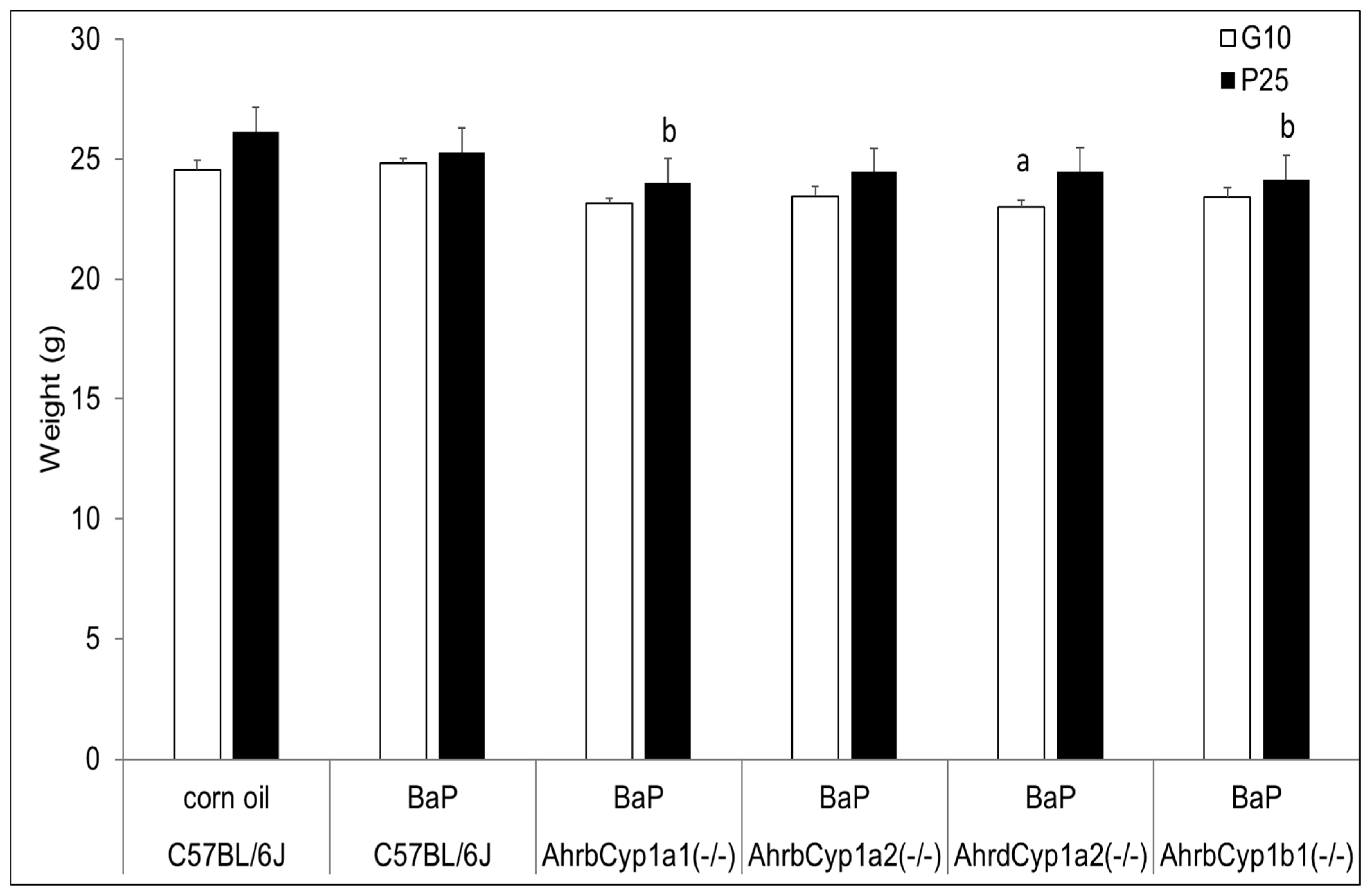
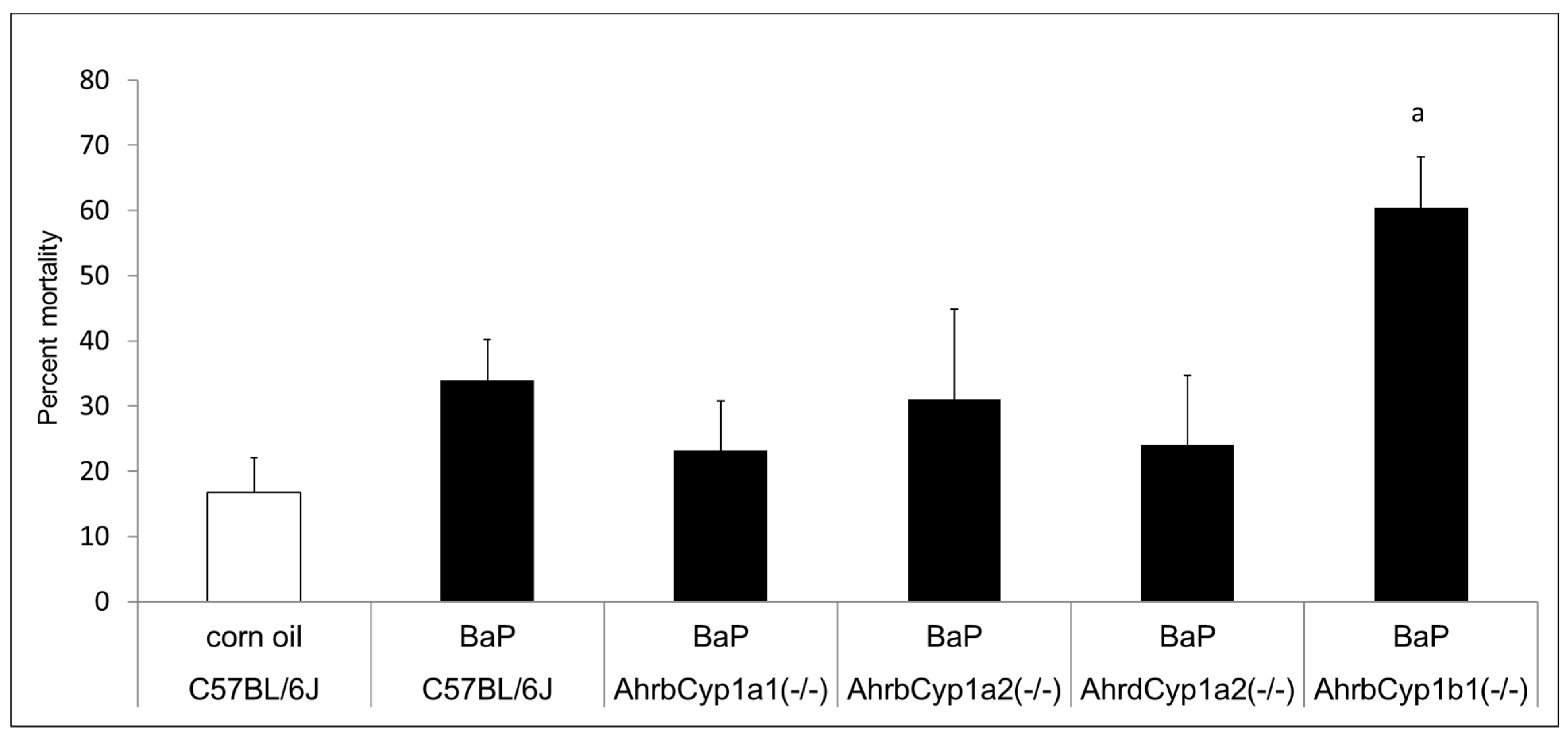

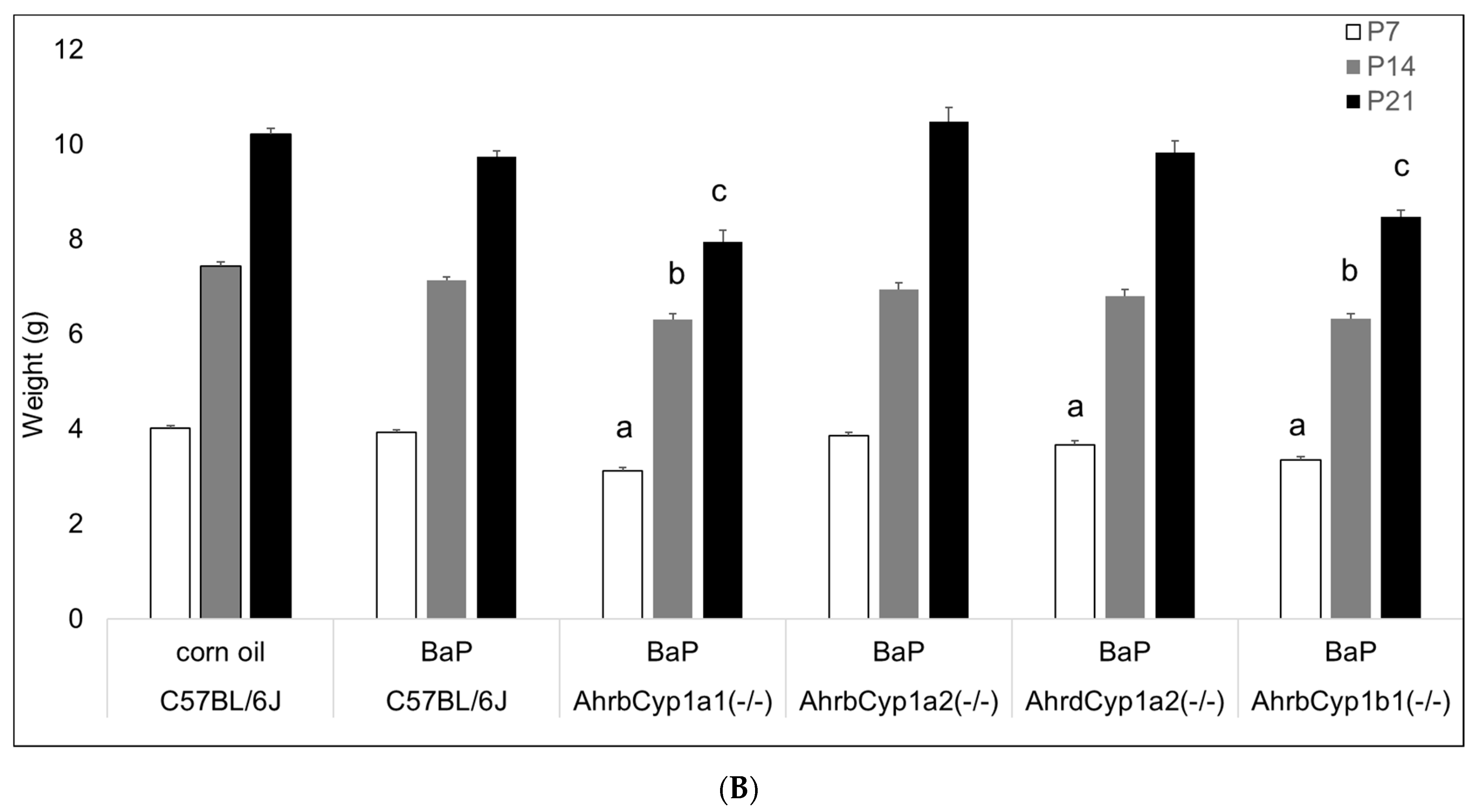
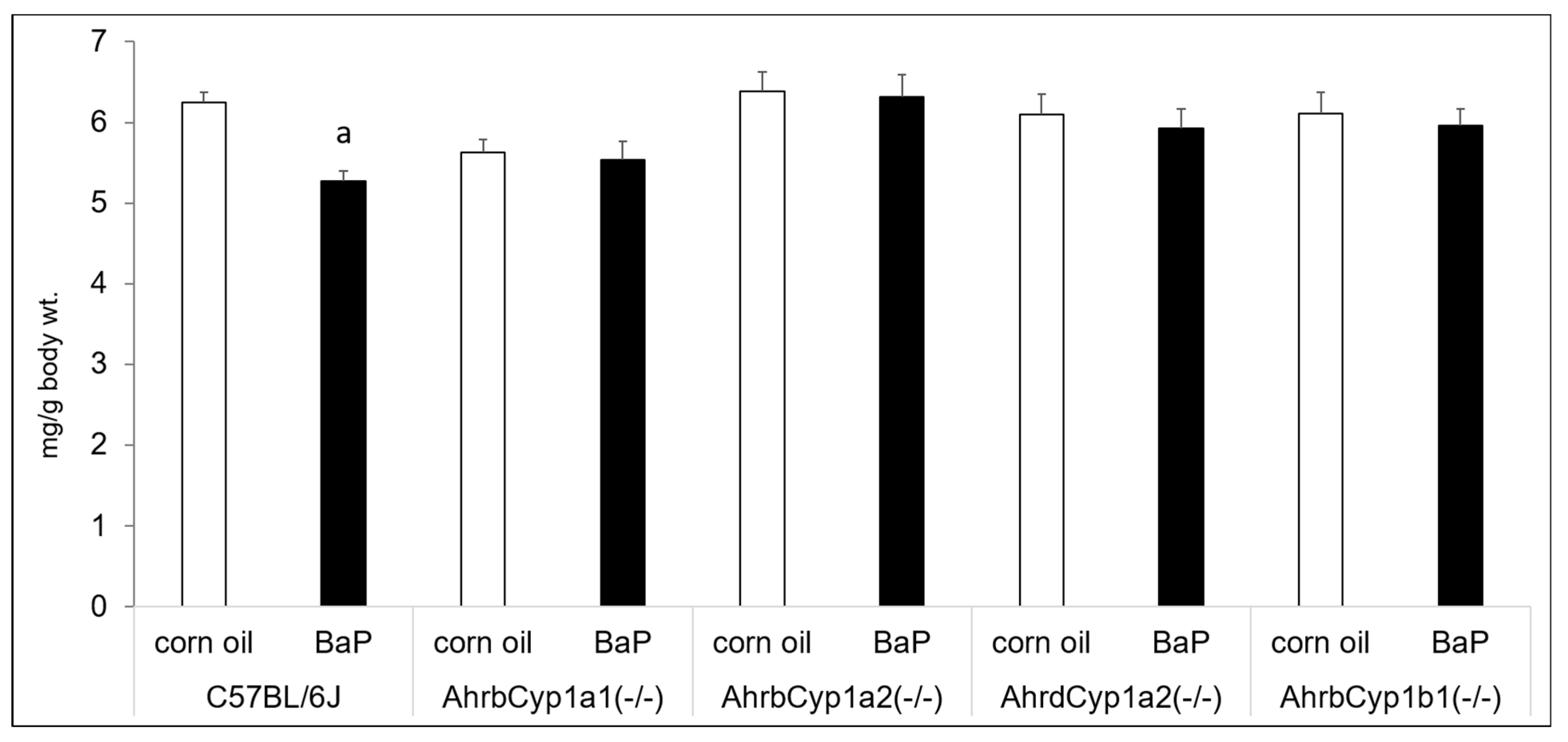
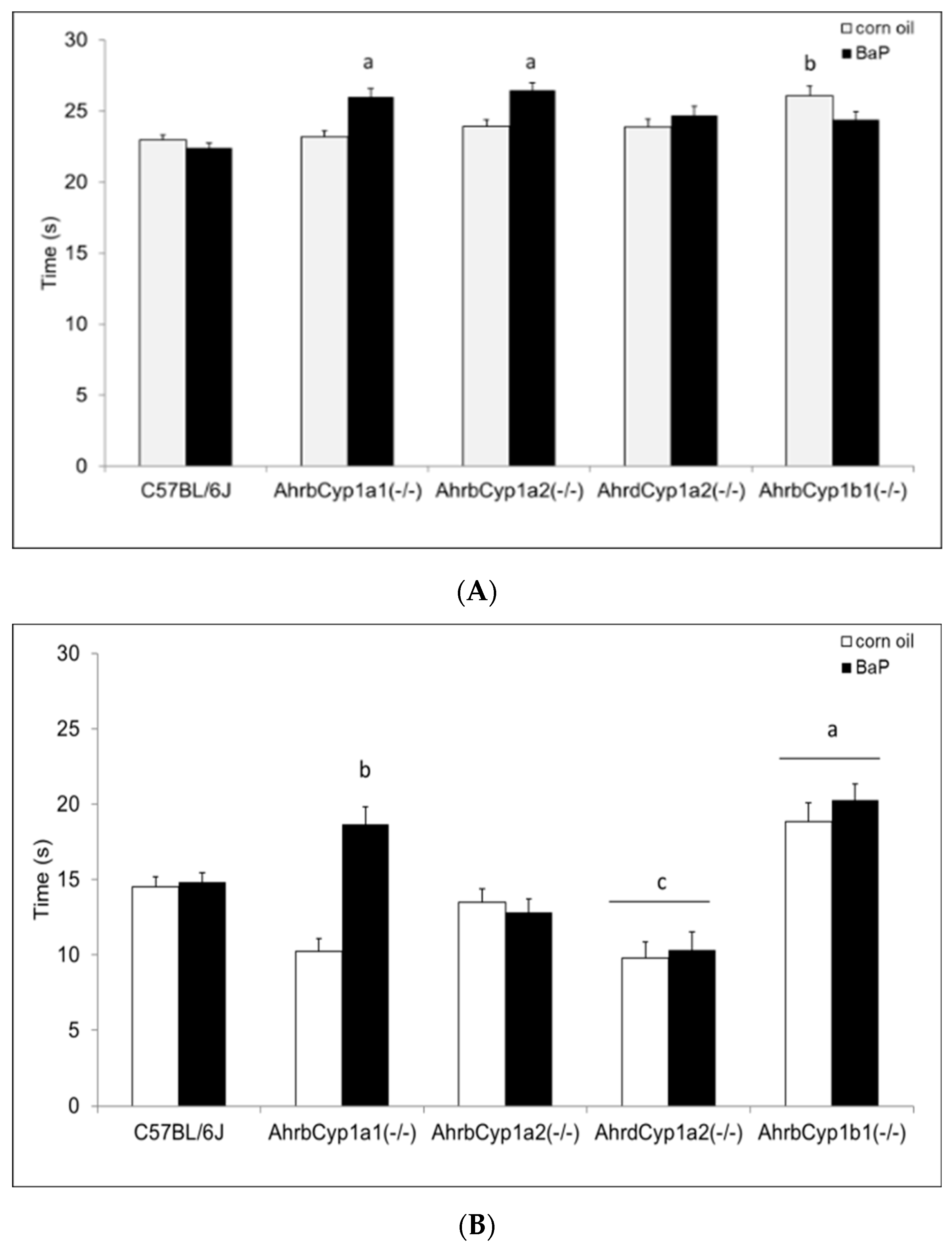
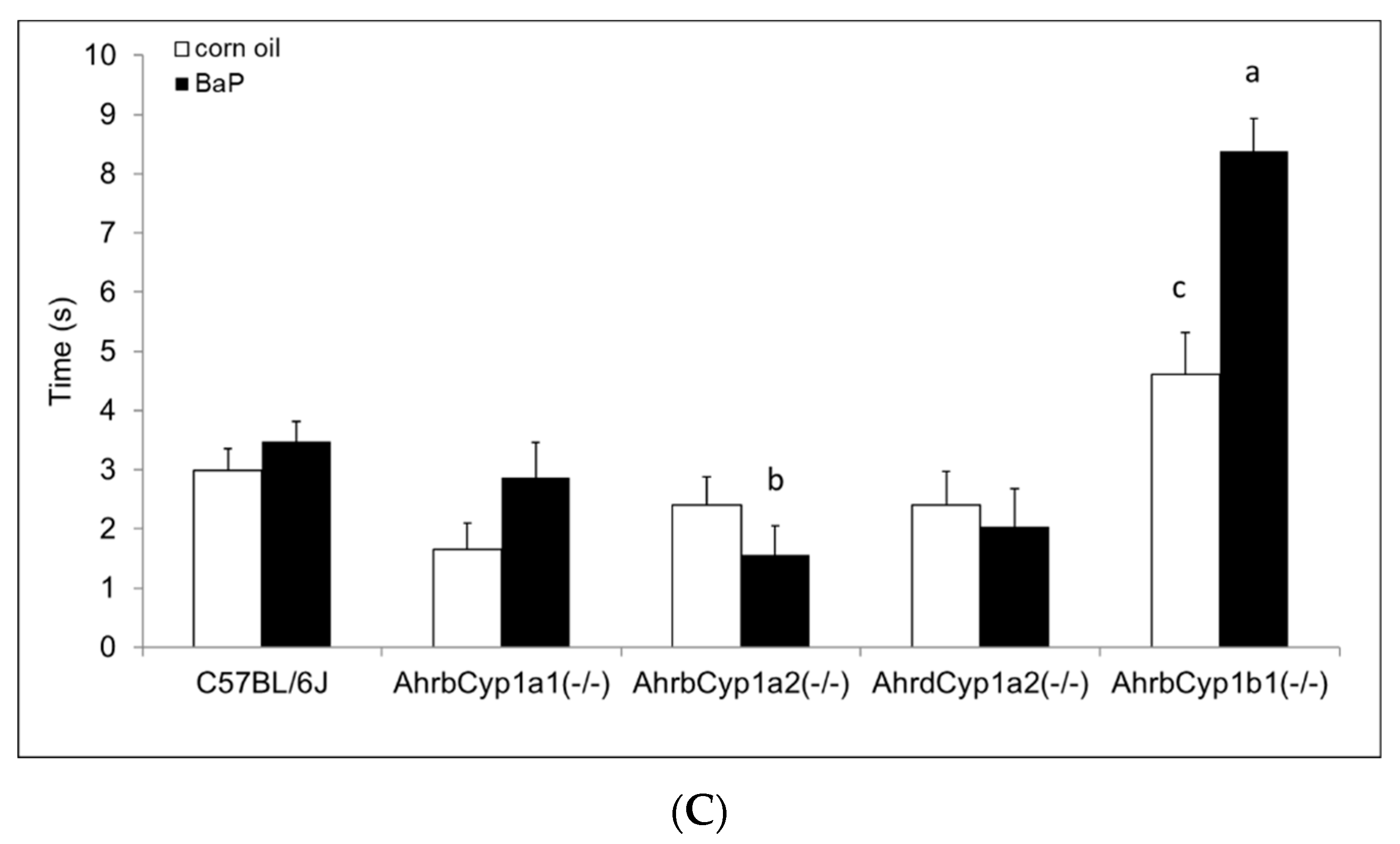


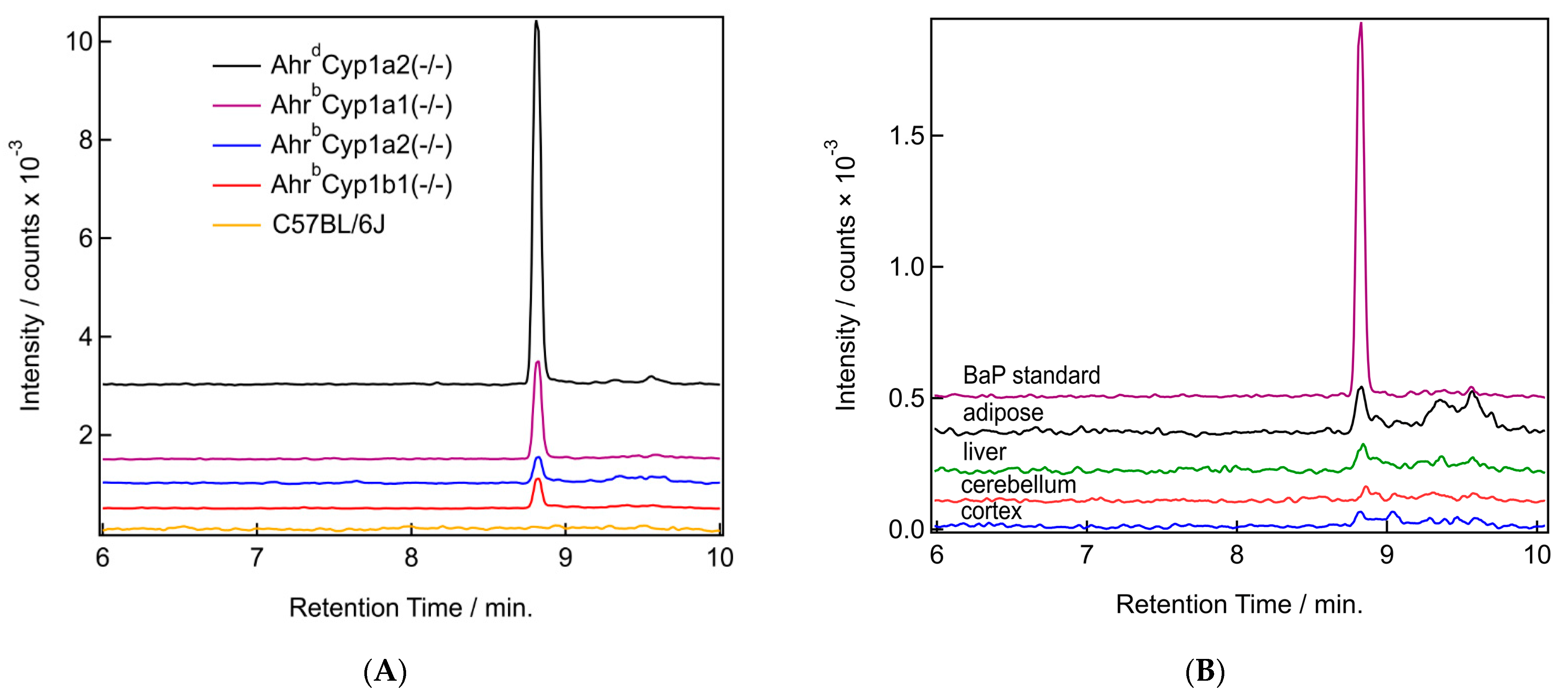

| Distribution of BaP in Dams and Pups | |||
|---|---|---|---|
| Genotype | Adipose (ng/mg Tissue) | Liver (ng/mg Tissue) | |
| C57BL/6J | dam | 0.031 ± 0.14 | 0.001 ± 0.02 |
| pup | 0.006 ± 0.13 | 0.017 ± 0.01 | |
| AhrbCyp1a1(-/-) | dam | 0.330 ± 0.22 | 0.009 ± 0.01 |
| pup | 0.259 ± 0.16 | 0.005 ± 0.01 | |
| AhrbCyp1a2(-/-) | dam | 0.050 ± 0.16 | 0.003 ± 0.01 |
| pup | 0.026 ± 0.13 | 0.004 ± 0.01 | |
| AhrdCyp1a2(-/-) | dam | 2.059 ± 0.15 | 0.074 ± 0.02 |
| pup | 0.031 ± 0.14 | 0.023 ± 0.02 | |
| AhrbCyp1b1(-/-) | dam | 0.057 ± 0.12 | 0.012 ± 0.02 |
| pup | 0.012 ± 0.11 | 0.031 ± 0.01 | |
| Distribution of BaP in Pup Brain | ||
|---|---|---|
| Genotype | Cortex (ng/mg Tissue) | Cerebellum (ng/mg Tissue) |
| C57BL/6J | 0.006 | ND |
| AhrbCyp1a1(-/-) | 0.007 | 0.036 |
| AhrbCyp1a2(-/-) | 0.007 | 0.043 |
| AhrdCyp1a2(-/-) | 0.011 | 0.009 |
| AhrbCyp1b1(-/-) | ND | 0.085 |
| Identification of BaP Metabolites | |||
|---|---|---|---|
| Metabolite | m/z | Retention Time | Found |
| BaP-3-OH | 269.09 | 6.74 | |
| BaP-7-OH | 269.09 | 6.77 | X |
| BaP-9-OH | 269.09 | 6.35 | X |
| BaP-12-OH | 269.09 | 6.68 | |
| BaP-4,5-diol | 287.099 | 3.02 | X |
| BaP-7,8-diol | 287.099 | 3.21 | |
| BaP-9,10-diol | 287.099 | 1.97 | |
| BaP-4,5-epoxide | 269.09 | 6.68 | |
Disclaimer/Publisher’s Note: The statements, opinions and data contained in all publications are solely those of the individual author(s) and contributor(s) and not of MDPI and/or the editor(s). MDPI and/or the editor(s) disclaim responsibility for any injury to people or property resulting from any ideas, methods, instructions or products referred to in the content. |
© 2023 by the authors. Licensee MDPI, Basel, Switzerland. This article is an open access article distributed under the terms and conditions of the Creative Commons Attribution (CC BY) license (https://creativecommons.org/licenses/by/4.0/).
Share and Cite
Feltner, M.; Hare, P.M.; Good, A.; Foster, E.G.; Clough, K.; Perry, J.; Honaker, A.; Kyntchev, A.; Kowalski, M.; Curran, C.P. Differential Susceptibility to Benzo[a]pyrene Exposure during Gestation and Lactation in Mice with Genetic Variations in the Aryl Hydrocarbon Receptor and Cyp1 Genes. Toxics 2023, 11, 778. https://doi.org/10.3390/toxics11090778
Feltner M, Hare PM, Good A, Foster EG, Clough K, Perry J, Honaker A, Kyntchev A, Kowalski M, Curran CP. Differential Susceptibility to Benzo[a]pyrene Exposure during Gestation and Lactation in Mice with Genetic Variations in the Aryl Hydrocarbon Receptor and Cyp1 Genes. Toxics. 2023; 11(9):778. https://doi.org/10.3390/toxics11090778
Chicago/Turabian StyleFeltner, Mackenzie, Patrick M. Hare, Asia Good, Emma G. Foster, Katelyn Clough, Jade Perry, Amanda Honaker, Angela Kyntchev, Mickayla Kowalski, and Christine Perdan Curran. 2023. "Differential Susceptibility to Benzo[a]pyrene Exposure during Gestation and Lactation in Mice with Genetic Variations in the Aryl Hydrocarbon Receptor and Cyp1 Genes" Toxics 11, no. 9: 778. https://doi.org/10.3390/toxics11090778
APA StyleFeltner, M., Hare, P. M., Good, A., Foster, E. G., Clough, K., Perry, J., Honaker, A., Kyntchev, A., Kowalski, M., & Curran, C. P. (2023). Differential Susceptibility to Benzo[a]pyrene Exposure during Gestation and Lactation in Mice with Genetic Variations in the Aryl Hydrocarbon Receptor and Cyp1 Genes. Toxics, 11(9), 778. https://doi.org/10.3390/toxics11090778







